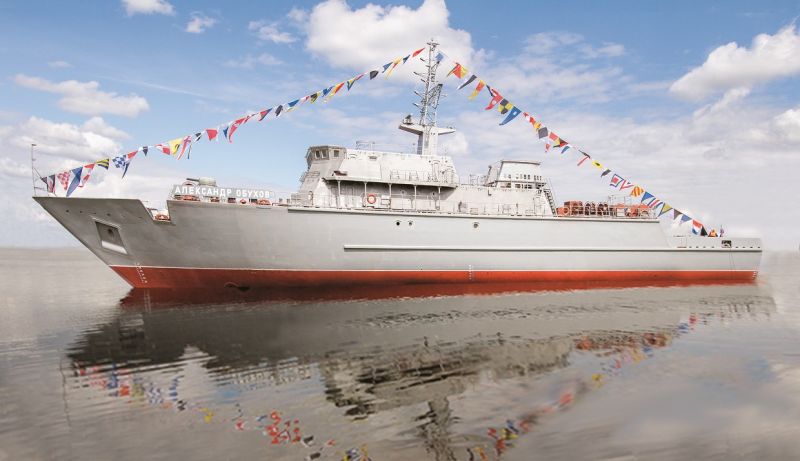Indian products and material can be part of Alexandrite ships - Alexander Shlyakhtenko, Almaz Marine
India is looking for two dozen mine counter measure ships for Indian Navy. Russian Alexandrit-E is one the major contender for the requirement. In a conversation with IDI, Alexander Shlyakhtenko, Director General, Almaz Central Marine Design Bureau (part of the United Shipbuilding Corporation) spoke at length on this offer to India.
By Rohit Srivastava

As India is making significant policy changes in its defence procurement policy and focusing towards increasing Indian content in imported system, Russian manufacturer of Alexandrite-E, mine counter measure vessel (MCMV), is ready to incorporate Indian content in its ship.
“We are ready to use both materials and products of Indian origin in the project,” said Alexander Shlyakhtenko.
India is in urgent need of 12 of these ships to protect its shipping lanes and ports.
Earlier this year, the head of Russia’s Federal Service for Military and Technical Cooperation (FSMTC) Dmitry Shugayev confirmed that Russia will offer its most modern anti-mine vessel Alexandrit-E for the tender.
India is yet to release tender for the MCMV program.
India has made multiple efforts to procure these vessels through global competition. In the last tender, South Korea’s Kangnam Corporation emerged front runner but the deal could not go through.
Speaking about its ship, Shlyakhtenkosaid, “The ships of 12700 Project have incorporated all the experience in the construction and operation of mine countermeasures (MCM) ships in the Soviet Union and the Russian Federation.”
Talking about the associated systems, he said that ship and its associated systems for search and destruction of mines, a hull mounted and towed countermine sonar stations as well as a self-propelled countermine submersible vehicle, were developed simultaneously.
“The task of creating a new ship and its countermine weapons was successfully solved, the lead ship joined the Russian Navy in 2016, and the serial construction began. On the basis of the lead ship, export modification 12701 Project (Alexandrit-E) was developed,” he added.
Talking about the technology involved in the ship, he said, “Manufacturing hulls from reinforced fiberglass (RFG), first of all, allows to achieve a low level of physical fields of the vessel, which is critically important for any MCM ship.”
Most of the anti-ship mine detonates when it comes in contact with the magnetic field of any ship. The RFG, produced through vacuum infusion technique, reduces the magnetic field of vessel as glass fiber is not magnetic in nature.
Calling Alexandrite class as seaworthy as any other ship of similar class, he said, “The ship's power plant is a twin-shaft diesel with variable-pitch propellers.”
“For the Russian Navy the ships of this project are equipped with Russian made main engines and diesel generators, but at the same time the volume of engine rooms and the layout solutions adopted in the project make it possible to install foreign-made engines for a potential foreign customer,” he added.
Talking about the ships’ counter measure systems, he said, “We offer the Project 12701 the Alexandrit - ISPUM-E integral MCM system. By having been used on the ships of 12700 Project this Russian-made system has confirmed the required specifications. At the same time, at the request of a foreign customer, it is possible to install foreign-made MCM systems.”
The ships of this class can simultaneously deploy both robotic countermine weapons, and contact and non-contact mine sweeps, Shlyakhtenko said.
Highlighting the open architecture of the control system of the ship, he said that Alexandrit-E has an open automated control system with the possibility of embedding various countermine weapons. “The system ensures the mutual exchange of information both between the countermine systems, and ship.”
Speaking on the possibility of building the ships under Make in India program, he said “In our opinion, such a possibility exists provided the proper technological preparation is carried out.”
He also informed that a passenger catamaran has been built at the Sredne-Nevsky Shipyard with the use of the similar technology .
India has nominated its government-owned Goa Shipyard Ltd as the production agency for the programme.
In the last few years, adversary submarines are regularly patrolling Indian Oceans. Submarines are the preferred vehicle to lay naval mines around adversary’s shipping lanes and ports.
To meet the operational requirement, India is procuring eight Clip Influence Sweep (CLOIS) for minesweeping requirements.
The 890 ton Alexandrit-E class is the latest Russian mine countermeasures vessel designed to detect and destroy mines of all kinds around naval bases, coastal sea, and can also provide mine protection to ships. It also can lay naval mines to defend the area of interest from ships and submarines.
Manned by a crew of 44, the ship, with sea endurance of 10 days, can cover a distance of 1500 nm at 16 knots.
The vessel operates Russian DIEZ-12700E automated system for mine countermeasures operation control and one LIVADIA-ME mine-detection sonar. The latter is designed to search and liquidation support of anchored, seabed, and bottom mines.
The lead ship of this class Alexander Obukhov and follow on ship Ivan Antonov is operational with Russian Navy. The third ship of the class is undergoing sea trials.
All Russian defence export programmes are executed through an exclusive agency Rosoboronexports.
Indian products and material can be part of Alexandrite ships - Alexander Shlyakhtenko, Almaz Marine




